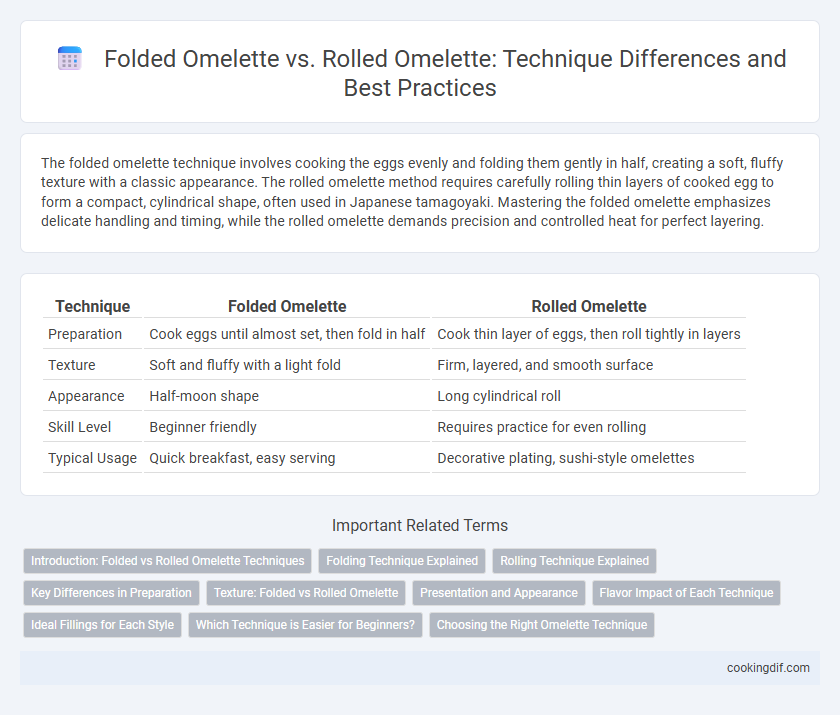The folded omelette technique involves cooking the eggs evenly and folding them gently in half, creating a soft, fluffy texture with a classic appearance. The rolled omelette method requires carefully rolling thin layers of cooked egg to form a compact, cylindrical shape, often used in Japanese tamagoyaki. Mastering the folded omelette emphasizes delicate handling and timing, while the rolled omelette demands precision and controlled heat for perfect layering.
Table of Comparison
| Technique | Folded Omelette | Rolled Omelette |
|---|---|---|
| Preparation | Cook eggs until almost set, then fold in half | Cook thin layer of eggs, then roll tightly in layers |
| Texture | Soft and fluffy with a light fold | Firm, layered, and smooth surface |
| Appearance | Half-moon shape | Long cylindrical roll |
| Skill Level | Beginner friendly | Requires practice for even rolling |
| Typical Usage | Quick breakfast, easy serving | Decorative plating, sushi-style omelettes |
Introduction: Folded vs Rolled Omelette Techniques
Folded omelettes involve cooking the eggs flat and folding them over a filling, creating a thick, tender texture with distinct layers. Rolled omelettes require constant motion in the pan, rolling the eggs into a cylindrical shape that results in a delicate, smooth surface often favored in Japanese cuisine, such as Tamagoyaki. Mastery of each technique depends on controlling heat and timing to achieve the desired consistency and appearance.
Folding Technique Explained
The folded omelette technique involves gently lifting one edge of the cooked egg and folding it over to create a soft, layered texture that remains tender inside, typically achieved by cooking over medium heat and careful timing. Unlike the rolled omelette, which requires continuously rolling the egg in a pan to form a compact cylinder, the folded omelette emphasizes a delicate fold that preserves fluffy curds and minimizes overcooking. Mastering the folding technique ensures a balanced moisture level and a visually appealing presentation, often favored in French culinary practices.
Rolling Technique Explained
The rolling technique in rolled omelettes involves carefully lifting and rolling the cooked egg layers with a spatula to create a smooth cylindrical shape, which requires steady heat control and precision to avoid tearing. Folded omelettes, on the other hand, are gently folded in half or thirds without rolling, producing a thicker, fluffier texture. Mastering the rolling technique allows for even cooking and a sleek appearance, often seen in Japanese tamagoyaki or French omelette styles.
Key Differences in Preparation
Folded omelettes are cooked on low heat until edges set, then gently folded in half for a soft, airy texture, emphasizing simplicity and quick preparation. Rolled omelettes require a precise technique, often using a thin pan layer, where eggs are gradually cooked and rolled repeatedly to create multiple layers, resulting in a firm, layered consistency. The key differences lie in heat control, cooking time, and folding versus rolling motions that define texture and presentation.
Texture: Folded vs Rolled Omelette
Folded omelettes typically have a fluffy, tender texture due to gentle cooking and a single fold that preserves pockets of air. Rolled omelettes, often cooked in thin layers and tightly rolled, result in a denser, more uniform texture with a smooth surface. The choice between folded and rolled techniques significantly influences the omelette's mouthfeel and overall texture experience.
Presentation and Appearance
Folded omelettes showcase a classic, smooth semicircular shape with a soft, fluffy interior visible at the edges, creating an inviting, elegant presentation. Rolled omelettes feature a cylindrical, spiral form with tightly wrapped layers that reveal a textured, ribbon-like cross-section appealing to visually dynamic plating. Chefs often choose folded omelettes for traditional, refined dishes, while rolled omelettes are preferred when a sleek, contemporary aesthetic is desired.
Flavor Impact of Each Technique
Folded omelettes create delicate layers that trap steam, resulting in a light, fluffy texture enhancing the egg's natural flavor. Rolled omelettes compress ingredients tightly, intensifying savory notes and offering a richer, denser bite. The choice between folding and rolling directly influences mouthfeel and flavor distribution in every bite.
Ideal Fillings for Each Style
Folded omelettes, characterized by their soft, fluffy texture, best complement delicate fillings such as herbs, cheese, and lightly sauteed vegetables that meld smoothly without overpowering the eggs. Rolled omelettes, with their firm structure and layered appearance, suit heartier fillings like ham, mushrooms, and spinach, allowing each ingredient to maintain distinct texture and flavor within the tight roll. Understanding the ideal fillings enhances each technique's visual appeal and taste profile, ensuring a perfect balance between egg and filling ingredients.
Which Technique is Easier for Beginners?
Folded omelettes are generally easier for beginners due to their simple cooking method, which involves cooking the eggs until set and then folding them in half. Rolled omelettes require a more precise technique, often involving non-stick pans and careful rolling to avoid breaking. The folded omelette's straightforward process makes it more accessible for those new to cooking.
Choosing the Right Omelette Technique
Choosing the right omelette technique depends on the desired texture and presentation; a folded omelette offers a soft, fluffy interior with a classic crescent shape, ideal for filling retention and elegant plating. In contrast, a rolled omelette, such as the Japanese tamagoyaki, requires precise heat control and layering, resulting in a firm, structured roll that enhances flavor integration and visual appeal. Mastering these techniques optimizes the cooking process, ensuring perfect consistency and taste tailored to specific culinary preferences.
Folded Omelette vs Rolled Omelette for technique Infographic

 cookingdif.com
cookingdif.com